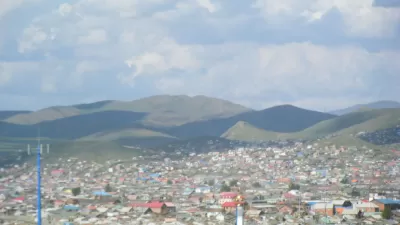Ulaanbaatar, the capital of Mongolia, was planned by the Russian government in the 1950s with extensive infrastructure and lush city parks. That infrastructure is deteriorating, while more of the nomadic population move to the city to survive.
40% of Mongolians are nomadic, following their herds around the countryside and living out of yurts (tent-like homes). That way of life is becoming harder to maintain, and the nomads are finding they must move to the capital to survive, moving into "yurt districts."
Sarah Bassett writes about Ulaanbaatar's history: "During Soviet occupation, the first master plan for Ulaanbaatar was developed and began its implementation in the 1950s, following with revisions in urbanization policy guaranteeing the planting of gardens and trees and provision of municipal services. By the 1980s, Ulaanbaatar was a vibrant city flush with park space, community friendly courtyards, functioning roadways, and infrastructure maintenance. It has been during the past twenty years that a massive change in the conditions of the city has occurred."
FULL STORY: Post-Soviet Urbanism in Mongolia, by Sarah Bassett

Maui's Vacation Rental Debate Turns Ugly
Verbal attacks, misinformation campaigns and fistfights plague a high-stakes debate to convert thousands of vacation rentals into long-term housing.

Planetizen Federal Action Tracker
A weekly monitor of how Trump’s orders and actions are impacting planners and planning in America.

In Urban Planning, AI Prompting Could be the New Design Thinking
Creativity has long been key to great urban design. What if we see AI as our new creative partner?

Cal Fire Chatbot Fails to Answer Basic Questions
An AI chatbot designed to provide information about wildfires can’t answer questions about evacuation orders, among other problems.

What Happens if Trump Kills Section 8?
The Trump admin aims to slash federal rental aid by nearly half and shift distribution to states. Experts warn this could spike homelessness and destabilize communities nationwide.

Sean Duffy Targets Rainbow Crosswalks in Road Safety Efforts
Despite evidence that colorful crosswalks actually improve intersection safety — and the lack of almost any crosswalks at all on the nation’s most dangerous arterial roads — U.S. Transportation Secretary Duffy is calling on states to remove them.
Urban Design for Planners 1: Software Tools
This six-course series explores essential urban design concepts using open source software and equips planners with the tools they need to participate fully in the urban design process.
Planning for Universal Design
Learn the tools for implementing Universal Design in planning regulations.
Appalachian Highlands Housing Partners
Gallatin County Department of Planning & Community Development
Heyer Gruel & Associates PA
Mpact (founded as Rail~Volution)
City of Camden Redevelopment Agency
City of Astoria
City of Portland
City of Laramie



























